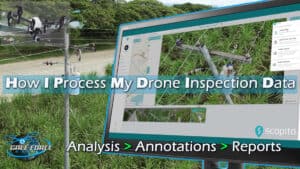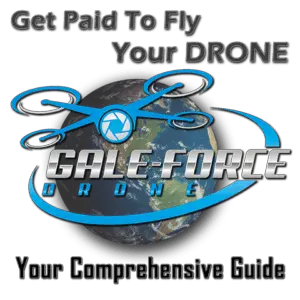
I remember when I bought my first drone back in 2016, I had no idea then that this new “toy” would lead me down a new career path. Maybe you’re in a similar situation and looking to monetize your drone, you might be wondering how to price your drone services at fair and profitable rates. Fortunately, pricing your drone services doesn’t have to be difficult. But first and foremost, it’s important to recognize that you’re not just charging for your time; you’re accounting for your expertise, equipment, and the investment you have made in yourself and your business to be an expert drone service provider.

Pricing Benchmarks and Competition
As part of your process of establishing your pricing structure, you will want to do some market research to get a good understanding of the demand for your specific service niche in your particular local market. Don’t let the term “Market Research” scare you, there is nothing difficult about it, it’s just a matter of taking some time to study your local area for demand and competition. This will help you more than you may realize because pricing will vary depending on factors such as your local area, your competition related to the specific services you offer.
Start out by going online. You can approach this as if you are a customer doing research to see who else is offering similar drone services in your area. Look at their pricing, services offered, and customer reviews to get an idea of what the local competition looks like. Look for their unique selling points, and then think about ways to differentiate your services from theirs.
Next, you will need to get a sense of the demand for your services in your area. This is not as easy, but you can call on potential clients such as real estate agents, construction companies, and event planners, not so much to sell them, but to understand their needs and pain points and what they might budget for your type of services.
And as a final component of your market research, you should also check into any regulations or laws that may impact how you price your drone services. Some countries or regions may require drone operators to obtain specific licenses or permits, which may impact your costs and ultimately your pricing.

Factors to Consider
When pricing your drone services, it’s important to factor in every aspect of the expense that goes into providing the deliverable. This means taking into account not only the cost of your time but also the cost of your equipment, expertise, and other associated expenses. This is how big companies do it, and in the same manner, you need to calculate the costs of each component of your service delivery.
There are many cost components that might be overlooked and when not included in your cost calculations, can cause you to go over budget and eat into your profits. Let’s take a look at the list below and remove all of the guesswork out of the equation, helping you to generate your bids intelligently and avoid losing profit on your projects.
- Let’s start with Manpower. This might be just you alone as the PIC (or Pilot in Command), or this could be a team consisting of a Lead PIC, drone techs, and other personnel. You should also include a per diem for each of your personnel to cover meals, or other on-the-job personal expenses. A well-cared for and happy team will give you a good days effort!
- Next we should consider our equipment. This can be everything from the Drone and Sensor(s) you will be using, to other gear needed, additional batteries and battery chargers, perhaps even a generator.
- The calculator that I use to help determine my cost for equipment. For the Drone and other high value assets, I use a depreciation model. For example, let’s say your new DJI Mavic 3 Classic cost you $1,500. The manufacturer warranty is 1 year, so that defines my depreciation schedule. Take the $1,749, divide it by 260 working days, equals about $7.00 per day. I realize this seems like a small amount, but these small amounts add up over time. For all of your gear, you can use the same formula to determine your per day or even per hour cost (divided by an 8 hour day).
- The next cost will be your transportation. In most cases, myself included, this will be your personal vehicle. This makes it all the more important to include this in your cost model. And even when you do invest in a dedicated company vehicle, you need to factor the cost into every job. Now, there are 2 ways that you can calculate your cost.
- The 1st calculator that you can use is the per mile scenario. The current mileage rate for 2023 is 65.5 cents per mile driven for business.
- The 2nd calculator you could use would be a day or hourly rate. In this scenario, this cost calculator should factor in the vehicle, maintenance, fuel and insurance.
- Another cost consideration might be overnight accommodations. This would obviously cover the cost of your lodging, but may also include meals and other associated costs involved.
- The next cost factor will be your computer equipment, software, or external subscriptions as well as you our your team members time involved in processing your drone data, and generating your deliverables that will go to the client.
- Other expenses you need to consider include training, insurance, licensing fees, marketing expenses, and office expenses. It’s important to account for these expenses in your pricing model to ensure that you are not undercharging for your services.
In the next section, I go into how to calculate your mark-up and profit.
 Click into my article “How I Process My Drone Inspection Data” to learn how I process my drone inspection data.
Click into my article “How I Process My Drone Inspection Data” to learn how I process my drone inspection data.

How to Mark-Up Your Pricing
And finally, now that you have your cost model generated for your project, we need to talk about profit. Since you have already done your market research and you have a good sense of the competitive landscape in your market, you will also have a good idea for what the going rates for your services should be.
It’s up to you to determine what you would like your profit to be, as well as what markup you will be able to charge. I have found that it works fairly well to use my actual cost, then calculate 50% markup. For example:
Project Cost @ $500 + 50% @ $250 = $750 Customer Price
Speaking personally, I am a strong proponent of going in with my best price on my initial proposal. If the client wants to negotiate a discount, then my advice would be to ask what part of the service they would like to deduct from the project. Then, once they have told me that they want the full scope of work, but they want a better price, then that is when you must decide what you can do. I will say that my Cost + 50% model has proven to be very competitive, and I seldom have any issues with my pricing.
The reasons I prefer this model is primarily the simplicity, transparency, and the ability to cover all costs and ensure profitability. The only downside might be the potential for overpricing. Just make a point to shop services occasionally to maintain market awareness.

The Pros and Cons of Different Pricing Models
Choosing the right pricing model is a critical decision for any drone services provider. In the previous section, I laid out my preferred “cost-plus” pricing method, but there are other pricing models that have their pros and cons, and depending on your preferences, you might find one of these to be more suitable for your specific type of service, market, or client. Some other pricing models include value-based, or hourly/day rates, each with its own approach to pricing and unique advantages and challenges. In this section, we will explore these pricing models and discuss the pros and cons of each to help you determine the most effective pricing strategy for how to price your drone services.
Value-Based Pricing: This pricing model can be great once you have a strong partnership with your client(s). Once the client knows and trusts you, your perceived value is now greater than what the market might dictate. The price can now be set at what the customer is willing to pay based on the value they believe they will receive.
The pros of this model include the ability to capture the full value of your service and potentially raise your profits.
The cons include the difficulty to accurately gauge customer value perception, as well as the potential for underpricing if the value is not properly established.
Fixed Fees: This pricing model involves charging a fixed fee for a service or project.
The pros include predictability and simplicity for both the provider and client, as well as the ability to factor in all costs to arrive at a fair and profitable price.
The cons include potential loss of profit if a project takes longer than anticipated or if there are unexpected costs.
- Time-Based Rates: This pricing model involves charging for services based on either hourly or day rates. Hourly rates involve charging a fixed amount per hour of work, while daily rates involve charging a fixed amount per day of work.
- The pros include easy calculation and transparency for the client, as well as the ability to charge more for specialized or complex services.
- The cons include potential inefficiencies that can be incentivized by time-based billing, and accurately estimating the time required for a project can be difficult. Additionally, day rates may be less than hourly rates multiplied by an 8-hour workday, which could result in lower profits for the service provider.
Overall, choosing the right pricing model depends greatly on the specific circumstances and your relationship with clients, as well as market demand and competition. In time you will develop a sense for the best pricing method, or perhaps a combination of pricing models, and if or when to adjust pricing based on feedback and experience.

In Closing...
As discussed, there are different pricing models to consider when setting rates for your drone services. Each approach has its own advantages and drawbacks, and the best choice ultimately depends on your business needs, client expectations, and market conditions. My personal preference is the cost + markup method, but I hope that you now have what you need to determine what works best for your business. By taking the time to carefully consider your pricing strategy and how to price your drone services, you can ensure that your business is both profitable and competitive in today’s market.

